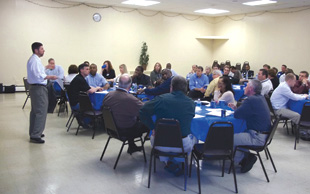As a general contractor, one of the first things you learn is that no matter how efficient your inner workings are or how dedicated your people are to a project, a large portion of your success, and ultimately the quality of the work, hinges on the successes of your project partners. From the owner to the architect to the suppliers and subcontractors, all parties have essential roles in completing a project on time and on budget. When it comes to the day-to-day progress of a project, however, few parties play a larger role than subcontractors.

Countless general contractors make the unfortunate choice of treating their subs as a dispensable means to an end. We’ve all heard stories of general contractors who show disrespect to their subs or refuse to make the final payments simply to pick up a few more dollars on the project’s bottom line. They get away with this by hiring a new set of subcontractors for each project.
This modus operandi is dishonest and shortsighted. By discarding subcontractors at the end of each project, a general contractor misses the opportunity to build efficiencies through long-term relationships. Not all subcontractors are created equal. If you have an extended network of subs who you trust and who trust you, your company is well-positioned to select the best subcontractor for the unique demands of a given project. Building long-term relationships not only improves your reputation, it also goes a long way toward increasing the quality of your work as a general contractor.
Communication Breeds Long-Term Relationships
The most important aspect of building successful relationships with subcontractors is maintaining an open line of communication along the entire workflow chain. Most of the time email is not enough. It is far too easy for conflicts in email exchanges between a young project manager and a headstrong subcontractor to become a full-blown issue when a 10-minute face-to-face meeting, or even a phone call, can defuse the situation.
A few years ago, our general contracting company was working with an automotive dealer on a facility remodel. In the beginning, the dealer was prompt with payments, making sure that invoices were paid five days after they were issued, thus satisfying the subcontractors on the job while keeping everything moving smoothly. Then the financial crisis hit.
A lot of things happened at once. The downturn in business, combined with a sudden unwillingness of banks to loan money, forced the dealer to switch to 60-day payment terms. As a result, the subcontractors—who themselves were facing uncertainty in matters of cash flow—became restless. Many threatened to walk off the job if the payment schedule was not returned to normal, jeopardizing the entire project.
To help alleviate tensions, we met with the dealer to discuss the extent of his cash-flow problems. After identifying a possible solution, we brought all parties to the table so that the dealer could present his case to the subcontractors. As a result, the subcontractors expressed a desire to continue the project and see it to completion. Some even worked out an agreement with the dealer and accepted new trucks for their businesses with the cost being applied to the value towards future payments.
In the end, this open dialogue among the owner, the subcontractor partners and us as the general contractor saved everyone a large headache and a fight over payments. Additionally, our standing with our subcontractors on that job greatly improved once they saw that we were invested in addressing their concerns and ensuring they were paid within a reasonable time frame.
When You Don’t Choose a Bid
Just as crucial to maintaining strong relationships with subcontractors is making sure that the boundaries and expectations surrounding those relationships are clear to all parties involved. Since a general contractor’s job is to complete a project on time and on budget, it is important that the bidding process for subcontractors remains competitive. As a result, not every job can, or even should, go to the same subcontractors. This can be a difficult fact to process for long-term subcontracting partners.
Maintaining open and transparent dialogue with your subcontractors can help smooth over any bumps that arise when their bid is not accepted on a project. Being honest about the subcontractor’s strengths and weakness, letting them know why they were not awarded a job and encouraging them to bid on projects that better fit their areas of expertise may not be what they want to hear at the time, but it helps to keep them as valuable contacts and partners in the long run.
Subcontractors are crucial pieces of the project puzzle. The key to maintaining those relationships, even through bumps in the road, is to maintain an ongoing dialogue between your company and its subcontracting partners.
